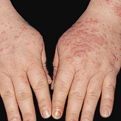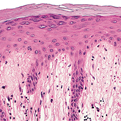Polymorphous Light Eruption
General Information
Polymorphous Light Eruption is a skin condition that occurs as a result of photosenitivity (sensitive to UV radiation). UV radiation can be found in sunlight, tanning lamps and tanning beds. Individuals that are sensitive to the light can experience a rash that appears mainly on the face, neck, sternal region, arms and dorsa of hands. The pruritic rash consists of papules, plaques, papulovesicles lesions can occur up to a day after exposure to UV radiation. Treatment for polymorphous light eruption is not necessary because the rash will usually resolve on its own between seven to ten days. Prevention should be the main key factor for patients. Recommendations include avoiding excessive sunlight, wearing protective clothing, and using sunscreens with at least 15 SPF (sun protection factor). Some sunscreens can protect against UV-A and UV-B light, “Broad spectrum” sunscreen that protects against UV-A and UV-B is recommended. Important ingredients in sunscreens preparation should include oxybenzone, sulisobenzone, dioxybenzone, avobenzone (Parsol 1789), titanium dioxide or methyl anthranilate.
Epidemiology
Affects around 10% of individuals in the United States
Etiology
Ultraviolet radiation
Pathogenesis
Pruritic red rash develops up to a day after being in the sun
Clinical
Papules, plaques, papulovesicles, and erythema multiforme lesions
Histology
Moderately dense superficial and deep perivascular infiltrate of lymphocytes. Marked edema of the papillary dermis.
Bibliography
1. “Polymorphous Light Eruption” (Online). March 2008. http://www.emedicine.com/DERM/topic342.htm (visited: April 2, 2008) 2. “Polymorphous light eruption” (Online). September 2007. http://www.emedicine.com/DERM/topic342.htm (visited: April 2, 2008)
Download PDF
![]() Polymorphous Light Eruption
Polymorphous Light Eruption


